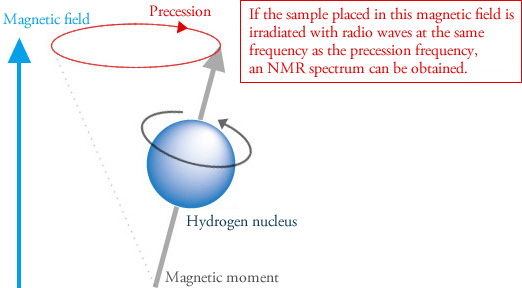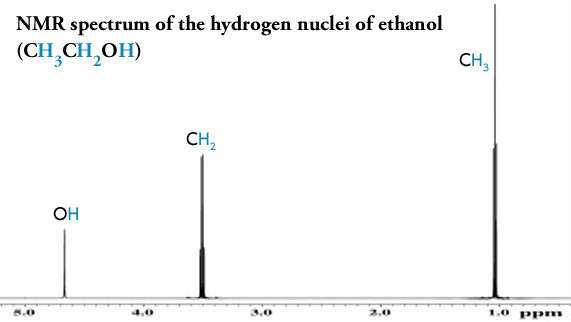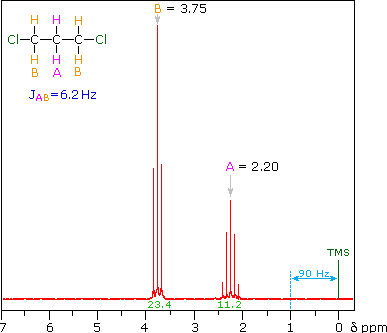Nuclear Magnetic Resonance Spectroscopy or NMR Spectroscopy can be used to identify any isotope unless the isotope has both an even number of protons and an even number of neutrons. The following diagram gives the approximate frequencies that correspond to the spin state energy separations for each of these nuclei in an external magnetic field of 235 T.

Analytical Chemistry A Guide To Proton Nuclear Magnetic Resonance Nmr Compound Interest
One is 12 which is anti-parallel to the magnetic field and the other is 12 which is parallel to the magnetic field.

. Solid-State NMR BDS Tutorial Pisa 2016 11 Spins in Alternating Magnetic Fields B 1 t 2B 10 cosω 0 t ω rf ω 0 During application of B 1. This is possible by the creation of magnetic field by placing the nuclei in the magnetic field. There are two major relaxation processes.
Mass spectrometry MS is an analytical technique that is used to measure the mass-to-charge ratio of ionsThe results are presented as a mass spectrum a plot of intensity as a function of the mass-to-charge ratioMass spectrometry is used in many different fields and is applied to pure samples as well as complex mixtures. The selection first takes a look at the fundamental principles and experimental methods. 1H and 13C are the most important NMR active nuclei in organic chemistry Natural Abundance 1H 999 13C 11.
Nuclear Magnetic Resonance Spectroscopy tutorial all along with the key concepts of Basic Principle of NMR The Source of NMR Spectra NMR spectrum Pattern of the Spectrum The. These moments are in nuclear magnetons which are 50507810-27 JT-1. Proton Nuclear Magnetic Resonance 1 H NMR Spectroscopy is a powerful method used in the determination of the structure of unknown organic compounds.
Precession of M around B 1 with a nutation frequency ω 1 γ B 1 B 1 field is applied as radio-frequency pulse 90 pulse. The applications of MRS as a research tool are extremely diverse encompassing studies on isolated cells body fluids and perfused organs at high magnetic field strengths in an experimental. Cross-polarization CP also called Proton-enhanced nuclear induction spectroscopy PENIS is a solid-state Nuclear Magnetic Resonance ssNMR technique to transfer nuclear magnetization from different types of nuclei via heteronuclear dipolar interactions.
The resonance is defined as the change in the nuclear spin of the nucleus from low energy state to high energy state by absorbing the energy. Nuclear Magnetic Resonance Spectroscopy tutorial all along with the key concepts of Basic Principle of NMR The Source of NMR Spectra NMR spectrum Pattern of the Spectrum The NMR spectrometer Operational procedure Application of NMR. The application of NMR spectroscopy to the study of proteins and nucleic acids has provided unique in- formation on the dynamics and chemical kinetics of these systems.
Welcome to the WSU Center for NMR Spectroscopy To combat the spread of COVID-19 effective September 8 2021 there is a more stringent procedure for using the NMR lab. The 1 H-X cross-polarization dramatically improves the sensitivity of ssNMR experiments of most experiments involving. The biomedical applications of nuclear magnetic resonance NMR are twofold.
Nuclear magnetic resonance NMR spectroscopy measurements have been firmly established among techniques used for obtaining valuable information about chemical and physical properties in a wide variety of scientific fields from biology and medicine to chemistry and physics. Magnetic resonance imaging MRI and magnetic resonance spectroscopy MRS. Nuclear Magnetic Resonance NMR Spectroscopy direct observation of the Hs and Cs of a molecules Nuclei are positively charged and spin on an axis.
1Increased magnetic field B Tutorial - Nuclear Magnetic Resonance Spectroscopy General Concepts Nuclear Magnetic Resonance NMR Spectroscopy is a technique used to determine the type number and relative positions of certain atoms in a. In certain specific circumstances MRS also provides means of performing kinetic. Nuclear magnetic resonance NMR is a spec- troscopic technique that detects the energy ab- sorbed by changes in the nuclear spin state.
Nuclear Magnetic Resonance Spectroscopy Second Edition focuses on two-dimensional nuclear magnetic resonance NMR spectroscopy high resolution NMR of solids water suppression multiple quantum spectroscopy and NMR imaging. A powerful technique useful for identifying the small to the very large When some atoms are placed in a strong magnetic field their nuclei behave. 13 C Nuclear Magnetic Resonance Spectroscopy Tutorial Key Concepts.
Nuclear Magnetic Resonance Spectroscopy or NMR Spectroscopy can be used to identify any isotope unless the isotope has both an even number of protons and an even number of neutrons. Download Citation Portable nuclear magnetic resonance spectroscopy probe Nuclear Magnetic Resonance NMR spectroscopy allows a reliable detection of chemical compounds in a sample that can be. They create a tiny magnetic field Not all nuclei are suitable for NMR.
E2 12 γh 2Π H0. 1 H μ 27927 19 F μ 26273 31 P μ 11305 13 C μ 07022. For the four common nuclei noted above the magnetic moments are.
The nuclei of many elements such as 13 C spin generating a magnetic field. 1 H Nuclear Magnetic Resonance Spectroscopy Tutorial Key Concepts. Magnetic resonance spectroscopy MRS is an analytical tool that detects radio frequency electromagnetic signals that are produced by the atomic nuclei within molecules.
The nuclei of many elements such as 1 H spin generating a magnetic field. If the molecule has no magnetic moment then only isotope molecules should posses the NMR spectra. Copyright 1997-2019 JP.
Nuclear magnetic resonance spectroscopy tutorial. Nuclear magnetic resonance NMR spectroscopy explores the electronic environment of atoms. It can be used to obtain in situ concentration measures for certain chemicals in complex samples such as the living brain.
During Chemistry 222 lab you will be using NMR extensively to help assign structures to two unknown organic compounds and this tutorial and exercises will hopefully help you solve your unknown. H0 is magnetic field which separates the energy into two.

Nmr Spectroscopy Basic Theory Youtube

Basic Introduction To Nmr Spectroscopy Youtube

Nmr Basic Knowledge Nuclear Magnetic Resonance Spectrometer Nmr Products Jeol

Nmr Basic Knowledge Nuclear Magnetic Resonance Spectrometer Nmr Products Jeol



0 comments
Post a Comment